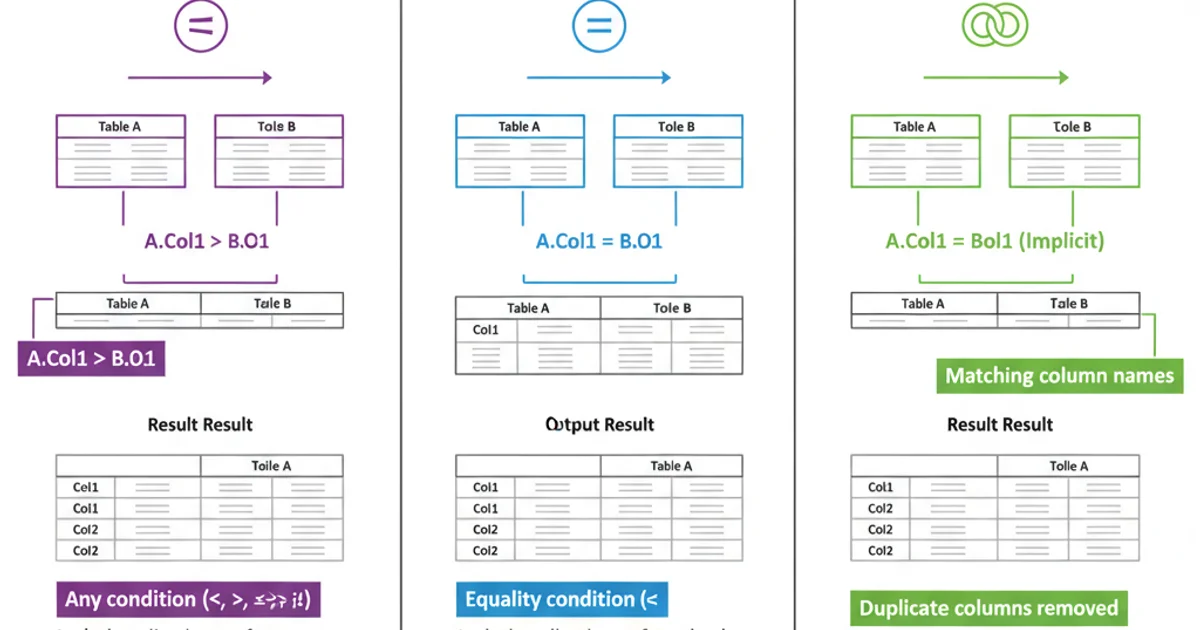Difference between a theta join, equijoin and natural join
Categories:
Understanding SQL Joins: Theta, Equijoin, and Natural Join

Explore the fundamental differences between Theta Join, Equijoin, and Natural Join in SQL, and learn when to use each for effective data retrieval and manipulation.
In relational databases, joins are crucial for combining rows from two or more tables based on related columns. While the concept seems straightforward, SQL offers various types of joins, each with specific characteristics and use cases. This article delves into three fundamental join types: Theta Join, Equijoin, and Natural Join, highlighting their distinctions and providing practical examples.
The Foundation: Theta Join
The Theta Join is the most general form of join in SQL. It allows you to combine rows from two tables based on any arbitrary condition that evaluates to true. This condition is specified using a comparison operator (e.g., =, <, >, <=, >=, !=, <>). Because of its flexibility, the Theta Join can be used to perform joins that are not necessarily based on equality, making it a powerful but sometimes less efficient option.
SELECT
E.EmployeeName,
P.ProjectName
FROM
Employees E,
Projects P
WHERE
E.EmployeeID > P.ProjectManagerID; -- Example of a non-equality condition
Example of a Theta Join using a greater-than condition
flowchart TD
A[Table A] -- Any Condition (θ) --> B[Table B]
B -- Result --> C[Combined Rows]
style A fill:#f9f,stroke:#333,stroke-width:2px
style B fill:#bbf,stroke:#333,stroke-width:2px
style C fill:#ccf,stroke:#333,stroke-width:2pxConceptual representation of a Theta Join
The Common Case: Equijoin
An Equijoin is a specific type of Theta Join where the join condition uses only the equality operator (=). It combines rows from two tables where the values in the specified columns are equal. Equijoins are by far the most common type of join used in relational databases because they are ideal for linking tables based on primary key-foreign key relationships. The result of an Equijoin typically includes all columns from both tables, potentially leading to duplicate columns if the join columns have the same name.
SELECT
E.EmployeeName,
D.DepartmentName
FROM
Employees E
JOIN
Departments D ON E.DepartmentID = D.DepartmentID;
Example of an Equijoin using the JOIN...ON syntax
flowchart TD
A[Table A] -- Equality Condition (=) --> B[Table B]
B -- Result --> C[Combined Rows with Matching Values]
style A fill:#f9f,stroke:#333,stroke-width:2px
style B fill:#bbf,stroke:#333,stroke-width:2px
style C fill:#ccf,stroke:#333,stroke-width:2pxConceptual representation of an Equijoin
WHERE clause can also be used for Equijoins (e.g., FROM TableA, TableB WHERE TableA.ID = TableB.ID), using the JOIN...ON syntax is generally preferred for clarity and better optimization by the database engine.The Implicit Join: Natural Join
A Natural Join is a specialized type of Equijoin that implicitly joins two tables based on all columns that have the same name and compatible data types in both tables. It automatically selects these common columns for the join condition and eliminates duplicate columns from the result set, presenting a cleaner output. While convenient, Natural Joins can be risky because they rely on column naming conventions. If column names accidentally match, it could lead to unintended join conditions and incorrect results.
SELECT
EmployeeName,
DepartmentName
FROM
Employees
NATURAL JOIN
Departments;
Example of a Natural Join. Assumes both tables have a column named 'DepartmentID'.
flowchart TD
A[Table A] -- Implicit Equality on Common Columns --> B[Table B]
B -- Result --> C[Combined Rows (Unique Common Columns)]
style A fill:#f9f,stroke:#333,stroke-width:2px
style B fill:#bbf,stroke:#333,stroke-width:2px
style C fill:#ccf,stroke:#333,stroke-width:2pxConceptual representation of a Natural Join
NATURAL JOIN with caution. It can lead to unexpected results if tables share column names that are not intended for joining. Explicitly specifying join conditions with ON or USING is generally safer and more robust.Key Differences and When to Use Each
Understanding the nuances of these join types is crucial for writing efficient and correct SQL queries. Here's a summary of their main differences and recommended usage:
- Theta Join: Most flexible, allows any comparison operator. Use when your join condition is not based on simple equality, or when you need to join tables based on complex logical expressions.
- Equijoin: Most common, uses only the equality operator (
=). Ideal for linking tables via primary key-foreign key relationships. Provides explicit control over join columns and is generally preferred for clarity and performance. - Natural Join: Implicitly joins on all common columns with matching names. Convenient for quick queries but risky due to reliance on naming conventions. Best avoided in production code unless column naming is strictly controlled and understood.

Comparison of Theta Join, Equijoin, and Natural Join